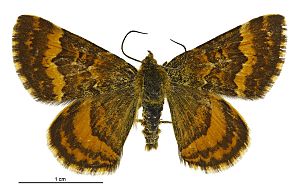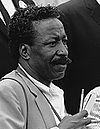Dasyuris partheniata facts for kids
Quick facts for kids Dasyuris partheniata |
|
|---|---|
 |
|
| Female | |
 |
|
| Male | |
| Scientific classification | |
| Kingdom: | |
| Phylum: | |
| Class: | |
| Order: | |
| Family: | |
| Subfamily: |
Larentiinae
|
| Genus: |
Dasyuris
|
| Species: |
D. partheniata
|
| Binomial name | |
| Dasyuris partheniata Guenée, 1868
|
|
Dasyuris partheniata is a species of moth in the family Geometridae. It is endemic to New Zealand. It is classified as "At Risk, Declining" by the Department of Conservation.
Taxonomy
This species was first described by Achille Guenée in 1868 from a specimen collected by Richard William Fereday in Canterbury. George Vernon Hudson discussed and illustrated the species in 1898 and again in 1928. He states that Fereday's specimens were collected at the foot of Mount Hutt. The holotype specimen is held at the Natural History Museum, London.
Description
The eggs of this species are yellowish-white in appearance, elliptical in shape and have hexagonal depressions on the surface.
Larvae are coloured pale yellow-brown on their dorsal side and a dull ocherous shade on their lateral side. They have 16 legs and are extremely thin.
The pupa is approximately 1+1⁄4cm long and is initially coloured pale yellow but darkens to golden then dark brown.
Hudson described the adults of the species as follows:
The expansion of the wings is about 1+1⁄8 inches. The fore-wings are bright orange-yellow ; the base is speckled with black and dull green scales ; there is a rather indistinct band at about one-third; a broad wavy dark brown band a little beyond the middle, with a projection towards the termen, followed by a clear space and another broad irregular dark transverse band; the termen is broadly bordered with dark brown, which is often almost continuous with the last-named transverse band. The hind-wings are bright orange; there is a large speckled area near the base edged with a curved black line, followed by a clear space, and an interrupted dark brown transverse line considerably beyond the middle ; the termen is rather narrowly edged with a dark brown line, wavy towards the base of the wing. The cilia of all the wings are yellow barred with black.
Distribution
D. partheniata is endemic to New Zealand. This species has occurred at Waiouru, the Tararua Range including at Mount Holdsworth, Wellington, Mount Arthur, Mount Hutt, Arthur's Pass National Park, Homer, Mount Cook, Dunedin, Lake Wakatipu, and at the Hump Ridge. The species can occur from sea level up to approximately 1500m in altitude.
Behaviour
D. partheniata larvae are nocturnal and when their safety is threatened drop to the centre of the plants they are feeding on. The larvae of this species has been observed, in the present of an Ichneumon wasp, gripping the blade of its foodplant with its prolegs and beating it with its body, causing the blade to move from side to side.
The adults of this species are day flying moths and are on the wing during the months of October to March.
Habitat
The species occurs in open grassy areas. In Wellington the species prefers coastal cliffs and at Mount Hutt specimens have been collected in tussock grass.
Host species
The host plants of this species are in the genus Aciphylla and include Aciphylla subflabellata.
Conservation status
This moth is classified under the New Zealand Threat Classification system as being At Risk and Declining.
 | Delilah Pierce |
 | Gordon Parks |
 | Augusta Savage |
 | Charles Ethan Porter |

